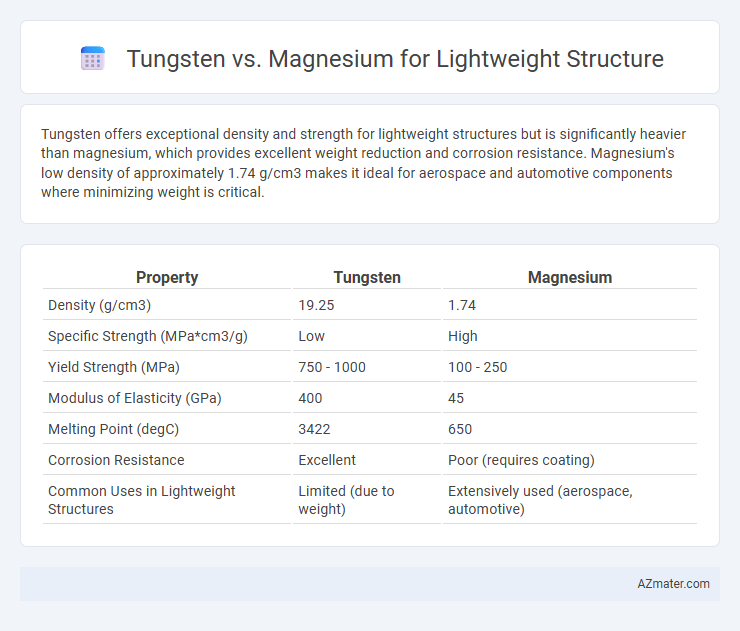Tungsten offers exceptional density and strength for lightweight structures but is significantly heavier than magnesium, which provides excellent weight reduction and corrosion resistance. Magnesium's low density of approximately 1.74 g/cm3 makes it ideal for aerospace and automotive components where minimizing weight is critical.
Table of Comparison
| Property | Tungsten | Magnesium |
|---|---|---|
| Density (g/cm3) | 19.25 | 1.74 |
| Specific Strength (MPa*cm3/g) | Low | High |
| Yield Strength (MPa) | 750 - 1000 | 100 - 250 |
| Modulus of Elasticity (GPa) | 400 | 45 |
| Melting Point (degC) | 3422 | 650 |
| Corrosion Resistance | Excellent | Poor (requires coating) |
| Common Uses in Lightweight Structures | Limited (due to weight) | Extensively used (aerospace, automotive) |
Introduction: Importance of Lightweight Materials
Lightweight materials are essential in aerospace, automotive, and structural engineering for enhancing fuel efficiency and performance while reducing emissions. Tungsten offers exceptional density and strength but poses challenges due to its high weight, whereas magnesium provides an excellent strength-to-weight ratio and corrosion resistance, making it ideal for lightweight structures. Selecting between tungsten and magnesium depends on balancing mechanical properties with weight constraints to optimize structural efficiency.
Overview of Tungsten and Magnesium
Tungsten exhibits exceptional density and high melting point, making it ideal for applications requiring high strength and thermal resistance, though its weight limits its use in lightweight structures. Magnesium, with its low density and good strength-to-weight ratio, is extensively favored for lightweight structural components in automotive and aerospace industries. The choice between tungsten and magnesium depends on balancing the need for durability, thermal stability, and overall weight reduction in engineered materials.
Physical Properties Comparison
Tungsten exhibits a high density of 19.25 g/cm3 and an exceptional melting point of 3422degC, making it significantly heavier and more heat-resistant than magnesium, which has a density of 1.74 g/cm3 and melts at 650degC. Magnesium's low density and excellent strength-to-weight ratio give it a clear advantage in lightweight structural applications, despite tungsten's superior strength and thermal stability. The contrast in their physical properties highlights magnesium's suitability for aerospace and automotive parts where weight reduction is critical, while tungsten's use is favored in environments requiring high thermal and wear resistance.
Strength-to-Weight Ratio Analysis
Tungsten exhibits exceptional strength with a tensile strength of approximately 1510 MPa but has a high density of 19.3 g/cm3, resulting in a lower strength-to-weight ratio compared to magnesium, which has a tensile strength around 200-350 MPa and a significantly lower density of 1.74 g/cm3. Magnesium alloys provide a superior strength-to-weight ratio, making them ideal for lightweight structural applications where reducing mass is critical without drastically compromising strength. Advanced magnesium composites and alloying techniques continue to enhance their mechanical properties, further optimizing their use in aerospace and automotive industries focused on lightweight design.
Corrosion Resistance and Durability
Tungsten offers exceptional corrosion resistance and durability due to its high melting point and oxidation resistance, making it ideal for harsh environments in lightweight structures. Magnesium, while significantly lighter and used extensively in aerospace and automotive sectors, is prone to rapid corrosion and requires protective coatings to enhance its longevity. In applications where corrosion resistance is critical, tungsten's superior durability outweighs magnesium's weight advantage despite its higher density.
Thermal and Electrical Conductivity
Tungsten exhibits high thermal conductivity around 174 W/m*K and electrical conductivity of approximately 18 x 10^6 S/m, making it ideal for applications requiring efficient heat dissipation and electrical performance in lightweight structures. Magnesium, with a lower thermal conductivity near 156 W/m*K and electrical conductivity about 2.3 x 10^6 S/m, offers a significant weight advantage but less efficiency in heat and electrical transfer. Selecting between tungsten and magnesium depends on balancing thermal and electrical conductivity needs against structural weight constraints in advanced engineering designs.
Machinability and Fabrication
Tungsten offers exceptional strength and high density but poses significant challenges in machinability due to its hardness and brittleness, requiring specialized tools and techniques. Magnesium is favored for lightweight structures because of its excellent machinability and ease of fabrication, allowing for faster production and complex shapes at lower costs. The choice between tungsten and magnesium depends on balancing strength requirements against fabrication efficiency and weight constraints.
Cost and Availability
Tungsten offers superior density and strength but is significantly more expensive and less abundant compared to magnesium, limiting its economical use in large-scale lightweight structures. Magnesium is widely available, cost-effective, and has one of the lowest densities among structural metals, making it ideal for lightweight applications despite lower strength and corrosion resistance. Cost-efficient magnesium alloys enable broad adoption in automotive and aerospace industries where weight reduction is critical.
Applications in Industry
Tungsten's exceptional density and high melting point make it ideal for applications requiring high thermal and wear resistance, such as aerospace turbine components and radiation shielding in medical devices. Magnesium's light weight and excellent strength-to-weight ratio provide significant advantages in automotive and aerospace industries for fuel efficiency and structural performance in chassis and body panels. Both metals are crucial in industry, with tungsten favored for high-stress environments and magnesium prioritized for lightweight structural designs.
Selecting the Best Material for Lightweight Structures
Tungsten offers exceptional density and high melting point, ideal for applications requiring substantial weight support despite its heaviness. Magnesium stands out for its ultra-lightweight properties and excellent strength-to-weight ratio, making it preferable for aerospace and automotive lightweight structures. Selecting the best material depends on balancing specific strength, weight constraints, and thermal requirements unique to the application.

Infographic: Tungsten vs Magnesium for Lightweight Structure
 azmater.com
azmater.com